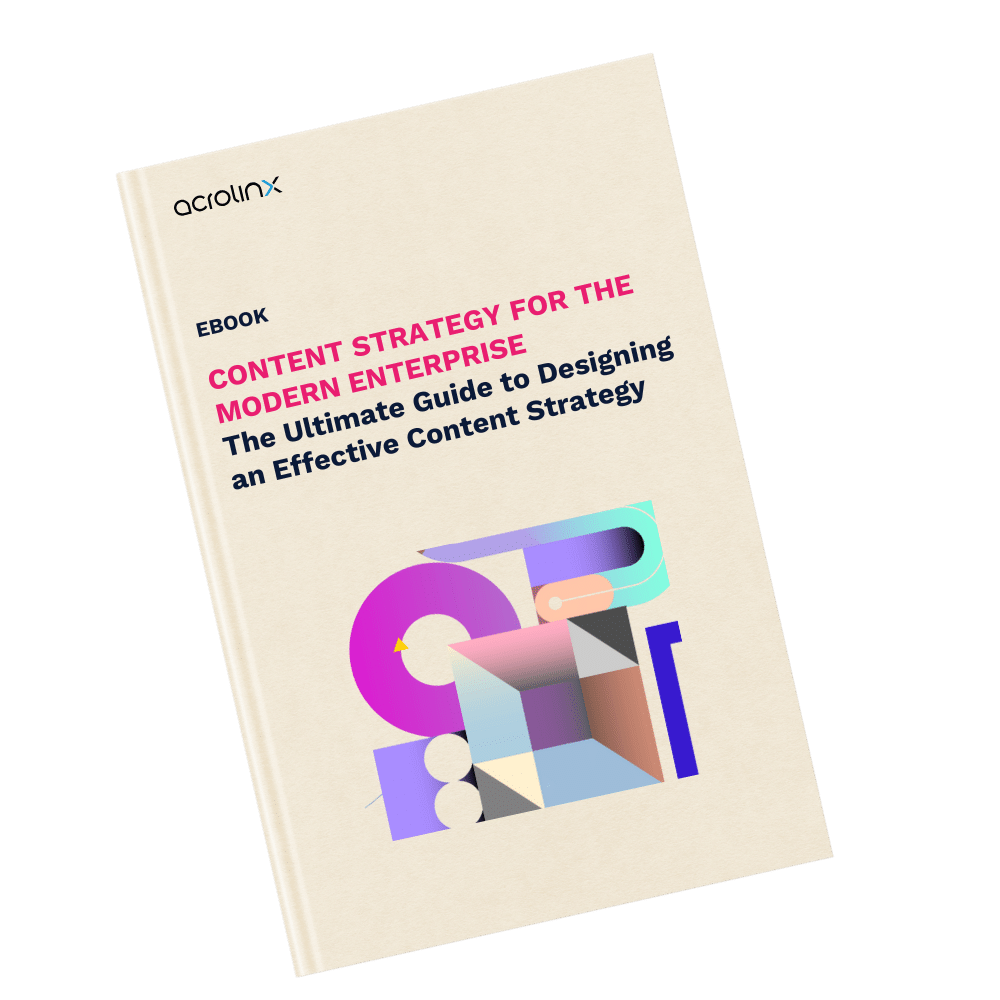
Content marketing. Everyone’s doing it, but how many of us know with certainty that we’re doing it well?
To get started with content marketing, you need a content marketing strategy. What is a content marketing strategy? Well, it’s a part of every marketer’s success plan that details how to manage any kind of content your enterprise creates and owns. It’s essential because it keeps your whole organization focused on your brand mission and the expertise you bring to your customers.
This isn’t just another blog post telling you how to create a B2B content marketing strategy and then share it with all your content contributors. This blog is here to help you know exactly what to document, and how to apply it across your enterprise in a way that increases the efficiency of your entire content operation. And with the same budget (or less) that you’re currently spending on content creation.
As a marketer, you probably already know that it’s not enough to simply produce any old content to serve your business. Your content also has to be high quality. But, if your marketers are still talking about “content quality” as part of your content marketing strategy, you need to go beyond the thought that, “We need better content than our competitors.” You need to discover what “better” means for your enterprise and your target audience. And how smart content governance can help you get there.
Turning your content marketing strategy into measurable actions
A content marketing strategy stays a strategy until you define what quality means for your business and turn it into measurable, trackable metrics. How does the clarity of your content lead to greater conversion rates? Does your content marketing strategy measure how well your tone of voice suits your different target audiences? How does a consistent brand style and language boost your brand awareness and customer loyalty? And how do you get the most out of what you’re spending on content marketing?
Without a centralized way to define, govern, and implement changes to your content strategy, you risk spending valuable time and resources on content marketing that simply isn’t effective. And if you don’t have a way for all writers to easily access approved guidelines for different content types, audiences, and distribution channels, you risk publishing content that can damage your customer relationships, and maybe even your brand as a whole. Don’t waste your content strategy with ineffective content management!
Recognizing content as a valuable business asset
Anyone who works in content marketing knows that content isn’t just a thing that happens magically in your company. You’re paying real people, real money to create it. And so content has a spend to it, but it’s likely your content marketing strategy hasn’t factored in the value of your content as an asset. That’s because the spend of content in big organizations is usually spread out across different teams, in different geographic locations. Every enterprise has a complex ecosystem of content, which is why you need smart content governance to control how you implement your content marketing strategy.
To start designing a content strategy that’s both cost effective and efficient, you’ll need to understand your enterprise’s current content ecosystem. This requires a broad understanding of how content is an asset, and the lifeblood of your business.
How to build a winning content marketing strategy
While you document your content marketing strategy, it’s in the best interest of the enterprise to have an overview of every piece of content in your content stockpile. Insights like how long it takes to create a piece of content (i.e., everything from a case study to blog posts and social media content), and what’s stopping you from improving that process at a team and writer level. And when you find out, you need a centralized system to set a baseline for your content standards and total alignment across your teams.
Only then can you start to see how alignment reduces communication risks and leads to efficiency, which gives you more time to focus on generating more value for your prospects and customers. Let’s look at the necessary steps for building a content strategy that serves your business:
1. Understanding your content ecosystem
Now is the time to ask yourself some key questions:
- How can I figure out how much content my organization is creating and maintaining?
- What is the standard of that content?
- How can I improve my content marketing strategy to get more out of that investment?
As it turns out, content marketing is way more than a well-crafted blog post or a playful social media stunt. It’s your biggest asset. Take this as an example:
A typical global life sciences website can have anywhere from 2 to 2.5 million pages of content. We’re talking about brochures, educational content, videos, links to social media, and legal information. It’s all created by different teams, but 90% of that content mentions the company’s product. If each page of content costs 1000 USD to create, and maintain (assuming the content is even used), content creation is costing that company 2.5 billion dollars. And that’s just the one-off spend, not including the additional costs of maintaining that content.
Now’s the time to jot down how many content pages you have, how many you actually maintain, and an estimate of how much you spend to create and maintain each page.
2. Identifying your business goals
Very often, your business goals and your content goals will overlap. And combining your business needs with user needs will create the basis of your strategy. Potential goals to consider are:
- Less content waste by reducing duplicate creation of content
- Content that meets user needs (customer self-service)
- Reducing the cost of content creation
- Reducing the editorial burden and preventing bottlenecks
- Documentation that keeps up with the pace of feature and product release cycles
- Greater conversion rates, lower bounce rates for web content
- Compliant content that reduces the risk of improper use of regulated terminology
- One coherent brand voice across every content channel
3. Defining the content your audience needs
This step starts with audience research. Who are you talking to and what are their challenges or goals? When designing content, you’ll need to focus on their goals, not just their preferences, which are the things they want or like (like glitter or cat memes). Focus on producing the content that helps them do the things they want, or need, to do. Other tips include:
- Make sure you’ve documented all the touchpoints in the user and buyer journey.
- Is your content really accessible to everyone you’d like it to be? Now’s the time to consider any digital limitations that might affect some of your target audience.
- Decide on the channels you’re going to use based on the needs of your audience. How do they interact with each other?
- Decide how you’ll collect feedback from your audience about whether you’re meeting their needs.
4. Auditing existing content
This is where you’ll review any content in your enterprise content repository and question whether it still serves your business goals, if it’s due for an update, or if it’s time to send it into retirement. Remember that every piece of content is costing your business money to maintain, so if content isn’t pulling its weight — it’s time to let it go.
It’s also helpful to keep some earlier content, analyze the ways it may or may not serve your business goals, and use it to set a benchmark for all future content.
5. Starting to build a content strategy
Until now, the process of building your content strategy has probably involved a handful of people. But it’s time to include senior management and executives. The main point at this stage is to make sure your recommendations are backed up by evidence, which is where the original analysis of your content asset is going to come in handy.
There will always be someone who doesn’t see the value of content as a whole, but if you show that you have a 2.5 billion dollar content asset, there’s no doubt your content strategy initiative will gain executive support.
6. Setting up content goals and defining success metrics
When we’re so close to our products and services, it’s easy to forget that they’re not as intuitive to our prospects and customers. Content marketing reinforces our expertise in our industry, but it shouldn’t do that at the expense of clear, readable content.
Let’s look at an organization who successfully connected the dots between their users’ needs and their business goals, and used it to improve their conversion rates in their content marketing.
Humana set a content goal for clear and readable content, after discovering that some of their customers thought their content was too complex. They conducted an A/B test with content of different levels of clarity. And guess what? Humana saw three times faster conversion rates when they improved the clarity of their messaging by 30%.
7. Setting up content governance to track the implementation of your strategy
When you set up smart content governance to control the delivery of your content marketing and alignment to your content marketing strategy, you have everything you need to create content that reaches your goals. Content governance should give you:
- An overview of your entire content operation to see (at a glance) where content needs improvement.
- Insights that align with your goals for your content, and measure what “quality” means for your enterprise.
- In-depth analytics that prove there’s real business value in your content asset.
- An ability to set benchmarks for different content types (such as blog posts, eBooks, long-form content, and web content) and see where they’re under-performing.
- Options for automatic alignment to your standards, to give you more time for high-value business activities.
To help choose the right tools to support your teams during the roll-out of your strategy, we can highly recommend this list of the top 10 content marketing strategy tools for 2020.
Your content marketing strategy — enterprise-wide
Acrolinx understands that the value your organization sees in content is specific to your business goals. That’s why Acrolinx is an AI platform you can customize to your enterprise. No matter which industry or role you’re in, Acrolinx makes it possible to extract genuine value from your content that’s relevant and tailored to your business goals. We use the power of content governance to get the most out of your content, and provide analytic insights that are meaningful to decision makers and team leaders.
These detailed metrics help you to plan efficient content creation, improve processes, and determine how your content is performing. With Acrolinx, it’s easy to see whether or not your content marketing strategy is working, and design an efficient content workflow based on data and insights.
Are you ready to create more content faster?
Schedule a demo to see how content governance and AI guardrails will drastically improve content quality, compliance, and efficiency.

Kiana Minkie
She comes to her content career from a science background and a love of storytelling. Committed to the power of intentional communication to create social change, Kiana has published a plethora of B2B content on the importance of inclusive language in the workplace. Kiana, along with the Acrolinx Marketing Team, won a Silver Stevie Award at the 18th Annual International Business Awards® for Marketing Department of the Year. She also started the Acrolinx Diversity and Inclusion committee, and is a driving force behind employee-driven inclusion efforts.





